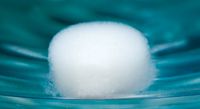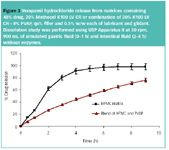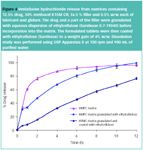Modulation of drug release from hydrophilic matrices
Pharmaceutical Technology Europe
Different chemistries and viscosities of HPMC can be combined to modulate release profile and, in some cases, result in a more robust formulation.
A hydrophilic matrix tablet is the simplest and most cost-effective method of fabricating an extended release (ER) solid oral dosage form. The majority of commercially available matrix formulations are in the form of tablets, and their method of manufacture is similar to conventional tablet formulations: granulation, blending, compression and coating. In its simplest form, a typical ER matrix formulation consists of a drug, one or more water-swellable hydrophilic polymers, excipients such as fillers or binders, a flow aid (glidant) and a lubricant. Other functional ingredients, such as buffering agents, stabilizers, solubilizers and surfactants, may also be included to improve or optimize the release and/or stability performance of the formulation system. Various water-soluble or water-swellable polymers with high molecular weight have been used in hydrophilic matrices, such as hypromellose (hydroxypropyl methylcellulose (HPMC)), hydroxypropylcellulose (HPC) and polyethylene oxide (PEO). HPMC is identified as the most popular polymer in matrix applications because of a number of key features and advantages:1–5

Image supplied by Colorcon
- Global regulatory acceptance.
- Excellent stability and non-ionic nature (resulting in pH-independent performance).
- Ease of manufacture through direct compression or granulation.
- Versatility and suitability for various drugs and release profiles (because of different chemistries and viscosity grades being available).
- Odourless and tasteless.
- Extensively studied and understood.
- Readily available.
Chemically, HPMC is mixed alkyl-hydroxyalkyl cellulose ether containing methoxyl and hydroxypropyl groups. A general structure of cellulose ether polymers is shown in Figure 1, where the R-group can be a single or a combination of substituents. Type and distribution of the substituent groups affect the physicochemical properties of the polymers. These properties coupled with the molecular weight distribution of cellulose ethers make them versatile for use in ER formulation of a wide range of drugs with varying solubilities and doses. Also, as cellulose ethers are non-ionic water-soluble polymers, the possibility of chemical interaction or complexation with other formulation components is greatly reduced and their matrices exhibit pH-independent drug release. Additionally, aqueous solutions of HPMC are stable within a wide pH range and are resistant to enzymatic degradation.3–11

HPMC is manufactured by The Dow Chemical Company (MI, USA), under the trade name of Methocel.6 Methocel used for ER hydrophilic matrix applications utilizes two types of chemical substituent groups signified by either 'E' or 'K' designations.7 Methocel polymers are also graded based on their viscosity (in cPs) of a 2% weight/volume aqueous solution at 20 °C, as shown in Table 1.

Figure 1
Typical HPMC grades utilized for ER formulations range in viscosity from 50 to 100000 cps at 20 °C, and include Methocel E50 Premium LV, K100 Premium LV CR, K4M Premium CR, K15M Premium CR, K100M Premium CR, E4M Premium CR and E10M Premium CR. The chemical substitution specification and viscosity grades are detailed in Table 1.

Figure 2
The mechanism of drug release from hydrophilic matrix tablets following ingestion is complex, but is known to be based on dissolution of the drug (if soluble), diffusion of the drug through the hydrated portion of the matrix and erosion of the outer hydrated polymer on the surface of the matrix. Typically, when the matrix tablet is exposed to an aqueous solution or gastrointestinal fluids, the surface of the tablet is wetted and the polymer hydrates to form a jelly-like structure around the matrix, which is commonly referred to as the 'gel layer'. This process is also termed as a glassy-to-rubbery state transition of the polymer (surface layer). The core of the tablet remains essentially dry at this stage. In the case of a highly soluble, high-dose drug, this phenomenon may lead to an initial burst release because of the presence of the drug on the surface and periphery of the matrix tablet. The gel layer (rubbery state) grows with time as more water permeates into the core of the matrix, increasing the thickness of the gel layer and providing a diffusion barrier to drug release.8 Simultaneously, as the outer layer becomes fully hydrated, the polymer chains become completely relaxed and can no longer maintain the integrity of the gel layer, leading to disentanglement and erosion from the surface of the matrix. Water continues to penetrate towards the core of the tablet, through the gel layer, until it has been completely eroded. Whereas soluble drugs are released by this combination of diffusion and erosion mechanisms, erosion is the predominant mechanism for insoluble drugs, regardless of dose.3,4 For successful ER of drugs, either soluble or insoluble, it is essential that polymer hydration and surface gel layer formation are quick and consistent to prevent immediate tablet disintegration and premature drug release. For this reason, polymers for hydrophilic matrices can be supplied in small particle size ranges to better ensure rapid hydration and consistent formation of the gel layer on the surface of the tablet.9

Table 1 Pharmaceutical grades of Methocel cellulose ethers and their USP specifications.
Although developing an HPMC matrix formulation may initially seem simple, the formulation scientist is required to consider a number of variables that influence drug release profiles, as well as the manufacturing and processing of these matrices.2,10–18 The release rate from the matrix is dependent upon factors including polymer type and level; drug solubility and dose; polymer: drug ratio; filler type and level; polymer to filler ratio; particle size of drug and polymer; and the porosity and shape of the matrix.2,10–18
Drug solubility is an important factor determining the mechanism of drug release from HPMC hydrophilic matrices as it influences the choice of polymer viscosity, chemistry grade and excipients. The use of an appropriate viscosity grade will enable a formulation scientist to design matrices based on diffusion, diffusion and erosion, or erosion mechanisms. Depending on drug solubility, it may be necessary to combine different viscosity grades of HPMC to effect an intermediate viscosity and achieve desired release kinetics.19
Combinations of HPMC polymers
In HPMC matrices, the effect of polymer concentration and viscosity (i.e., molecular weight) on drug release rates can be predicted using the Phillipof equation.19 This mathematical relationship can be used in combining different viscosity grades of HPMC to obtain an intermediate viscosity for achieving the desired release characteristics. The influence of mixing different polymer viscosity grades on an eroding HPMC matrix of a practically insoluble drug (nifedipine) is represented in Figure 2.20 Erosion is the principal mechanism of drug release for such poorly soluble drugs, and generally a low viscosity grade of polymer (e.g., Methocel K100 Premium LV CR) is used in such formulations.
It was observed that the dissolution profile of the initial formulation was slower than the United States Pharmacopeia (USP) requirement and showed dependency on in vitro testing conditions as a faster dissolution rate was observed when the paddle speed was increased from 100 to150 rpm (Figure 2). Such in vitro behaviour may indicate a variable in vivo release rate and, possibly, 'food effect'.21,22 The study showed that a blend of high-viscosity grade HPMC (Methocel K15M Premium CR) to increase the gel strength, and a low viscosity grade HPMC (Methocel E15 Premium LV) to allow for consistent erosion — as indicated by the Phillipof equation — can be used to achieve the desired release profile and meet USP requirements. Mixing these two viscosity grade polymers also produced matrices with improved physical characteristics that exhibited similar dissolution profiles at agitation speeds of 100 and 150 rpm (Figure 2). This example demonstrates that combining HPMC polymers not only modulated the release profile to the desired degree, but also produced a more robust matrix system.
Combinations of HPMC with ionic and non-ionic polymers
Combining polymers of different chemistries or viscosities has been extensively studied as a means of achieving and optimizing extended drug release from hydrophilic matrices. HPMC is typically used as the primary polymer in such systems, but its functionality can be augmented by a variety of other polymers; for example, HPMC of different viscosity grades has been combined with ionic or non-ionic polymers to modulate drug release.23–49
Combinations of HPMC with ionic polymers
Among ionic polymers, anionic polymers have been widely investigated in combination with HPMC for modulating the release profile of various drugs. The examples of anionic polymers studied include sodium carboxymethylcellulose (Na CMC);23–27 sodium alginate;28–30 polymers of acrylic acid or carbomers (Carbopol 934, 940, 974P NF);31–34 enteric polymers such as polyvinyl acetate phthalate (PVAP),50 methacrylic acid copolymers (Eudragit L 100, L 30D 55, S and FS 30D),35–38 hypromellose acetate succinate (AQOAT HPMCAS);39 and xanthan gum.40,41 Incorporation of cationic polymers has also been noted, specifically utilizing Eudragit E 100 (dimethylaminoethyl methacrylate copolymer).
Baveja et al. advocated combining HPMC with Na CMC to effect a zero order release of the drugs propranolol hydrochloride, metoprolol tartrate and alprenolol hydrochloride.23 The hypothesis was that the polymers showed a synergistic increase in viscosity that allowed erosion to occur at a rate equating to the movement of the front between the glassy and rubbery polymer. However, it was later confirmed that enhancement in viscosity was not solely responsible for modulating the drug release profile, and that the complex formation between the anionic polymer and cationic drug also played an important role.24 Similar interaction with cationic drugs has also been demonstrated for methacrylic acid copolymers (Eudragit S and Eudragit L 100-55).36
Combining HPMC with sodium alginate has also been proposed for obtaining a pH-independent release profile for basic drugs.51 When the matrix is exposed to an acidic environment, the HPMC (pH-independent polymer) hydrates to form a gel layer at the surface of the tablet while the sodium alginate remains insoluble, acting as a barrier to diffusion of the drug. As the pH increases with passage of the tablets from the stomach to the intestinal tract, the sodium alginate in the matrix begins to swell and hydrate, contributing to the overall barrier to drug diffusion and matrix erosion. It has been claimed that drug release from this system remains independent of pH.28,51
Carbomer (Carbopol) is an anionic polymer used in formulating matrices, but its performance is reported to be variable with fluctuations in release.31 Combining carbomers (Carbopol 940 and 974P NF) with HPMC produces a synergistic increase in viscosity of the matrix because of stronger hydrogen bonding between the carbomer and HPMC.31,32 This stronger cross-link between the two polymers results in a more rigid structure through which drug diffusion can occur. The net result of this interaction is increased consistency of drug release profile versus HPMC matrix alone.
Incorporation of anionic polymers, most notably enteric polymers, in HPMC matrices is attractive for developing a pH-independent release profile for weakly basic drugs.52,53 When formulated with HPMC matrices alone, these drugs lead to a pH-dependent drug release profile that exhibits a higher release in acidic pH and a lower release in basic pH because of the pH-dependent solubility of the drug.
The incorporation of anionic polymers in the matrix can influence drug release in basic media by lowering the microenvironmental pH, and can also retard the drug release in acidic media by forming an insoluble mass that acts as a barrier to drug diffusion. A combination of these two opposing effects can result in pH-independent release of the drug. Moreover, as these enteric polymers have comparatively high molecular weights, they show longer residence time within the matrix gel layer, possibly facilitating their pH modulation effect to last longer compared with 'smaller molecular weight' acids such as citric acid.52,54 In addition to the control of microenvironmental pH, anionic polymers may alter the gel strength and erosion rate of the matrix and, therefore, the release rate of the drug.
Combining PVAP with HPMC to formulate matrices containing verapamil hydrochloride (HCl) has been reported.50 When the formulation was subjected to dissolution according to USP 28 (method 1) in simulated gastric fluid (0–1 h) followed by intestinal fluid (2–8 h), slower drug release was observed from multipolymer compositions when compared with the single HPMC polymer matrix (Figure 3). As PVAP is soluble in simulated intestinal fluid, it is expected to behave as a soluble-filler and result in a faster drug release rate. It is proposed that the retardation of drug release is attributable to the synergistic interaction between PVAP and HPMC, resulting in the formation of a stronger gel layer and, consequently, slower diffusion and erosion rates.
Similar to the development of pH-independent matrices for basic drugs, incorporation of cationic polymers in HPMC matrices has been reported for developing pH-independent ER matrices for weakly acidic drugs.54 Combining Eudragit E 100 with HPMC matrices has been shown to result in pH-independent release for acidic drugs (such as divalproex sodium). This effect has been attributed to enhanced solubility and, hence, the release of the drug in acidic media and retardation of the drug release in basic media.

Figure 3
Combinations of HPMC with non-ionic polymers
Addition of non-ionic polymers to HPMC has been shown to slow dissolution rate; for example, it has been reported that the addition of HPC to HPMC matrices caused further retardation to the release profiles.42,43 This retardation has been attributed to a stronger gel layer of the resultant matrix, reducing the diffusion and erosion rate characteristics of the gel layer.44 Another non-ionic polymer of interest for mixing with HPMC is PEO (POLYOX; The Dow Chemical Company, MI, USA).55 PEO is available in various molecular weight grades, ranging from 100000 to 7000000 Da and is the fastest hydrating water-soluble polymer among the hydrophilic polymers. The inclusion of PEO in HPMC matrices could be beneficial in cases where slower initial drug release is required or when a shift in mechanism of drug release is desirable.45–49,56
Combinations of HPMC and water insoluble polymers
Highly water-soluble drugs formulated with HPMC matrices may be characterized with an initial burst effect. Mixing of water-insoluble polymers with HPMC could circumvent this problem as they decrease the penetration of water in the matrix, leading to decreased diffusion of the drug and slower initial release. The water-insoluble polymers that could be incorporated in the HPMC matrix include ethylcellulose (e.g., ETHOCEL or Surelease), cellulose acetate, methycrylic acid copolymers (e.g., Eudragit NE 30D), ammonio-methacrylate copolymers (e.g., Eudragit RL 100 or PO RS100) and polyvinyl acetate.38,50,52,57,58
Combinations of HPMC and water-insoluble fatty acids, alcohols or waxes have also been investigated with varied degrees of success.59–61 Low melting lipophilic materials blended at low concentrations (≤7.5% w/w) with HPMC have shown potential in achieving ER of metformin, a high-solubility active, suggesting the possibility of niche applications for such matrix blends.59–61 However, combinations of HPMC with lipophilic materials at higher concentrations have produced mixed results. While one researcher suggested levels of 20% w/w or more to tailor the drug release profile, other sources have shown the failure of such systems to provide extended release.59–61
Figure 4 shows the use of an insoluble polymer, ethylcellulose, in combination with HPMC to reduce the initial burst release.57 Here, a highly soluble API (venlafaxine HCl) has been granulated with an aqueous dispersion of ethylcellulose (Surelease; Colorcon, PA, USA) before incorporation into an HPMC matrix. The formulation was further modified by coating the matrices with a barrier membrane (ethylcellulose film) to suppress the initial burst effect.57

Figure 4
Conclusions
HPMC hydrophilic matrix systems have been widely studied and many successful products in the market utilize this versatile extended release technology. Different chemistries and viscosities of HPMC can be combined to modulate release profile and, in some cases, result in a more robust formulation. HPMC matrices offer a platform for mixing other polymers to provide flexibility to the formulator in achieving the desired release profile. Ionic, non-ionic and insoluble polymers have been used in HPMC matrices to successfully modulate the release profile of various drugs. The addition of ionic polymers has been shown to not only modify the drug release profile, but also allow microenvironmental pH control of the gel layer, which may enhance the solubility or stability of drugs.
References
1. D.A. Alderman, Int. J. Pharm. Tech. Prod. Mfr.,5, 1–9 (1984).
2. J.E. Hogan, Drug Dev. Ind. Pharm.,15, 975–999 (1989).
3. C.L. Li et al.,J. Pharm. Pharmacol.,57, 533–546 (2005).
4. A.R. Rajabi-Siahboomi and M.P. Jordan, Eur. Pharm. Rev., 5, 21–23 (2000).
5. S. Siepe et al., Int. J. Pharm.,316, 14–20 (2006).
6. Colorcon, "Extended/Controlled Release" (2008). www.colorcon.com
7. US Pharmacopeia-NF Online, "USP Monographs: Hypromellose" www.uspnf.com
8. A.R. Rajabi-Siahboomi et al.,Pharm. Res.,13, 376–380 (1996).
9. The Dow Chemical Company, "Methocel products", (2008). www.dow.com
10. P. Gao et al., J. Pharm. Sci.,85, 732–740 (1996).
11. I.J Hardy, W.G. Cook and C.D. Melia, Int. J. Pharm.,311, 26–32 (2006).
12. Y. Huang et al., Drug Dev. Ind. Pharm.,29, 79–88 (2003).
13. M. Levina and A.R. Rajabi-Siahboomi, J. Pharm. Sci.,93, 2746–2754 (2004).
14. K. Mitchell et al.,Int. J. Pharm., 100, 165–173 (1993).
15. K. Mitchell et al., Int. J. Pharm.,66, 233–242 (1990).
16. A. Nokhodchi et al., Int. J. Pharm.,129, 21–31 (1996).
17. A. Nokhodchi et al., J. Pharm. Pharmacol., 48, 1116–1121 (1996).
18. A.R. Rajabi-Siahboomi, A. Nokhodchi and M.H. Rubinstein, Pharm. Technol. Yearbook, 32–40 (1998).
19. The Dow Chemical Company, "Using Dow excipients for controlled release of drugs in hydrophilic matrix systems", (2006). www.dow.com
20. A.V. Gothoskar et al., "Controlling the release of nifedipine (a practically insoluble drug) using hypromellose matrices", at the Controlled Release Society 33rd Annual Meeting and Exposition (Vienna, Austria, July 2006).
21. B. Abrahamsson et al.,Eur. J. Pharm. Biopharm.,46, 69–75 (1998).
22. B. Abrahamsson, K. Roos and J. Sjogren, Drug Dev. Ind. Pharm., 25, 765–771 (1999).
23. S.K. Baveja, K.V. Ranga Rao and K. Padmalata Devi, Int. J. Pharm.,39, 39–45 (1987).
24. M.A. Dabbagh, Pharm. Dev. Technol.,4, 313–324 (1999).
25. N. Vatsaraj, H. Zia and T. Needham, Drug Deliv.,9, 153–159 (2002).
26. S. Conti et al.,Int. J. Pharm.,333, 136–142 (2007).
27. S. Conti et al., Int. J. Pharm.,333, 143–151 (2007).
28. P. Timmins, A.M. Delargy and J.R. Howard, Pharm. Dev. Technol.,2, 25–31 (1997).
29. Y.B. Huang et al., Int. J. Pharm., 289, 87–95 (2005).
30. P. Giunchedi et al., AAPS PharmSciTech., 1, E19 (2000).
31. S.M. Samani, H. Montaseri and A. Kazemi, Eur. J. Pharm. Biopharm.,55, 351–355 (2003).
32. S.M. Khamanga and R.B. Walker, "Comparison of method of manufacture on in vitro performance of verapamil matrix tablets", at the Controlled Release Society 32nd Annual Meeting and Exposition (Miami, FL, USA, July 2005).
33. S.A. Bravo, M.C. Lamas and C.J. Salomon, Pharm. Dev. Technol., 9, 75–83 (2004).
34. S. Li, Int. J. Pharm.,253, 13–22 (2003).
35. S. Takka, Farmaco, 58, 1051–1056 (2003).
36. S. Takka, S. Rajbhandari and A. Sakr, Eur. J. Pharm. Biopharm.,52, 75–82 (2001).
37. B.M. Al-Taani and B.M. Tashtoush, AAPS PharmSciTech.,4, E43 (2003).
38. R.C. Rowe, P.J. Sheskey and S.C. Owen (Eds.), Handbook of Pharmaceutical Excipients (Pharmaceutical Press, London, UK, 2006).
39. A. Streubel, J. Control Release,67, 101–110 (2000).
40. J. Varshosaz, N. Tavakoli and S.A. Eram, Drug Delivery, 13, 113–119 (2006).
41. M.C. Gohel, Boll. Chim. Farm.,141, 21–28 (2002).
42. C.H. Hsiao, US Patent 4556678 (1985).
43. N.K. Ebube and A.B. Jones, Int. J. Pharm.,272, 19–27 (2004).
44. M.L. Vueba, Pharm. Dev. Technol.,11, 213–228 (2006).
45. C.S. Fuller, Polymer, 42, 9583–9592 (2001).
46. R.J. Macrac and J. Sarah, WO 97/18814 (1997).
47. L. Yang and R. Fassishi, J. Control Rel., 44, 135–140 (1997).
48. L. Yang and R. Fassihi, Int. J. Pharm., 155, 219–229 (1997).
49. G. Gusler, US Patent 6723340 (2004).
50. A.R. Rajabi-Siahboomi et al., US Patent application 20070048377 (2007).
51. J.R. Howard and P. Timinis, US Patent 4792452 (1998).
52. A.S. Tatavarti et al., J. Pharm. Sci., 93, 2319–2331 (2004).
53. A.S. Tatavarti and S.W. Hoag, J. Pharm. Sci.,95, 1459–1468 (2006).
54. V.M. Rao, K. Engh and Y. Qiu, Int. J. Pharm., 252, 81–86 (2003).
55. The Dow Chemical Company, "POLYOX products" (2008). www.dow.com
56. C.J. Kim, J. Pharm. Sci.,84, 303–306 (1995).
57. V.D. Dias et al., "Modulation of drug release from hypromellose (HPMC) matrices: suppression of the initial burst effect", at The American Association of Pharmaceutical Scientists Annual Meeting and Exposition (San Antonio, TX, USA, 2006).
58. C.D. Melia, Crit. Rev. Ther. Drug Carrier Syst.,8, 395–421 (1991).
59. B.B. Lohray and S.B. Tiwari, WO/2005/123134 (2005).
60. S.B. Tiwari et al.,AAPS PharmSciTech.,4, E31 (2003).
61. L. Ochoa et al., J. Pharm. Pharm. Sci.,8, 132–140 (2005).
Acknowledgements
The authors thank Kurt Fegely, Dr. Abhijit Gothoskar and Viena Diaz (all from Colorcon Inc.) for their experimental contributions to the data presented in this paper.
Sandip B. Tiwari is Manager, New Product Development, Modified Release Technologies, at Colorcon Inc. (PA, USA).
Ali R. Rajabi-Siahboomi is Global Technical Director, Modified Release Technologies, at Colorcon Inc. (PA, USA).

Drug Solutions Podcast: A Closer Look at mRNA in Oncology and Vaccines
April 30th 2024In this episode fo the Drug Solutions Podcast, etherna’s vice-president of Technology and Innovation, Stefaan De Koker, discusses the merits and challenges of using mRNA as the foundation for therapeutics in oncology as well as for vaccines.
Drug Solutions Podcast: Applying Appropriate Analytics to Drug Development
March 26th 2024In this episode of the Drug Solutions Podcast, Jan Bekker, Vice President of Business Development, Commercial and Technical Operations at BioCina, discusses the latest analytical tools and their applications in the drug development market.
INTERPHEX 2025: Use of Walk-In Chambers for Bio/Pharma Development and Manufacturing
April 2nd 2025Sitting down with the PharmTech Group at INTERPHEX 2025, Christopher Murphy, director of Global Business Development and Service Customer Support at Environmental Specialties, discusses the design and critical role of walk-in chambers in the bio/pharmaceutical industry.